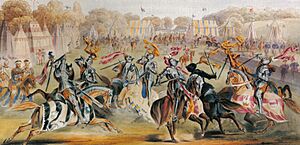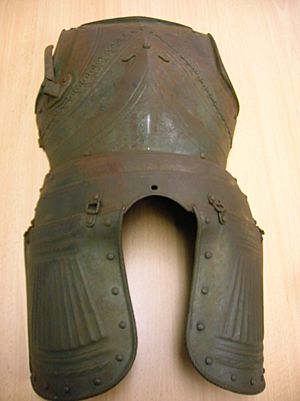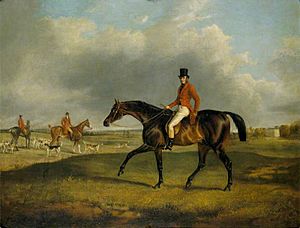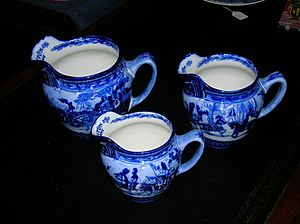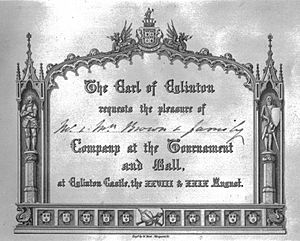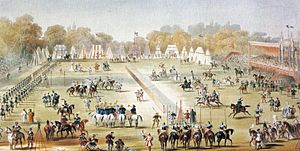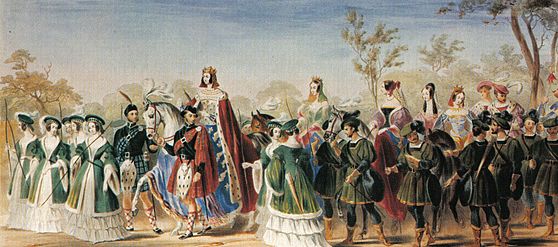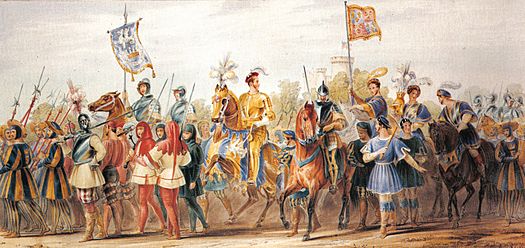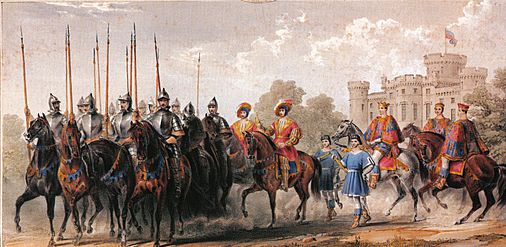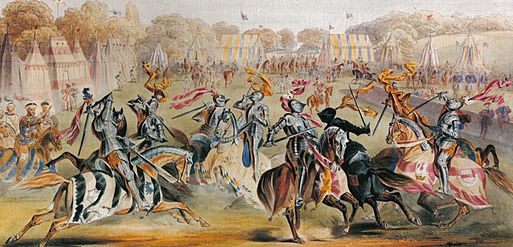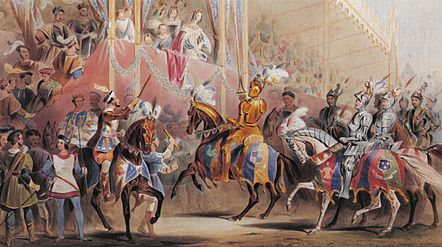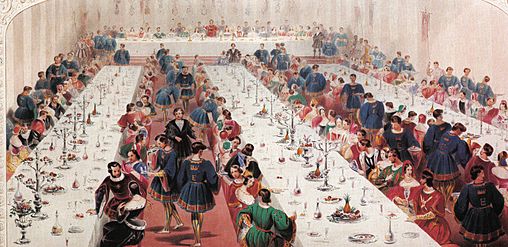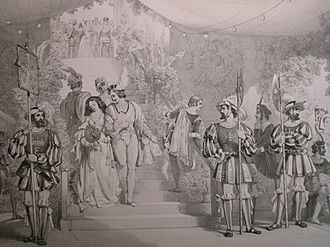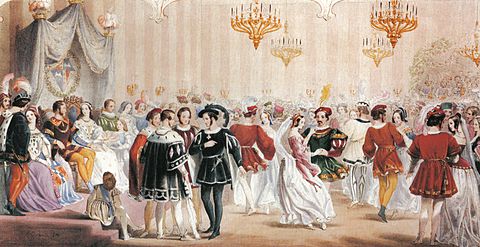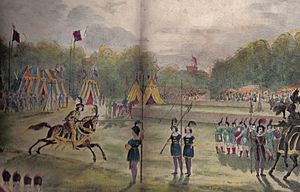Eglinton Tournament facts for kids
The Eglinton Tournament of 1839 was a grand event that brought back the excitement of medieval jousting and feasts. It happened in North Ayrshire, Scotland, from August 28 to 30. Archibald, Earl of Eglinton, paid for and organized this huge show at his home, Eglinton Castle. Many important guests attended, including Prince Louis Napoleon, who later became the Emperor of France. The "Queen of Beauty" for the tournament was Georgiana, Duchess of Somerset.
This tournament was a way to celebrate Romanticism, a popular movement at the time that looked back to older times. About 100,000 people came to watch! It's often remembered for the problems caused by heavy rain. People had mixed feelings about it at the time. One newspaper said, "Even on Wednesday, when the procession was seen to the greatest possible disadvantage, the dullest eye glistened with delight." This shows how impressive the event was, even with bad weather. The knights had trained a lot for the jousting.
The tournament and the art it inspired helped bring back interest in Gothic Revival style in the 1800s. It also led to other big historical events, like the Brussels Tournament in 1905. The Eglinton Tournament was actually inspired by Walter Scott's famous novel Ivanhoe. Lord Eglinton himself said he wanted to "revive chivalry."
While others made money from the event, Lord Eglinton lost a lot of his own money. His granddaughter later remembered that he "had spent most of the wealth of the estate."
Contents
Why the Tournament Happened
During the late 1700s and early 1800s, there was a big interest in medieval times. This was part of the Gothic Revival and Romanticism movements. For example, medieval-style jousts were held in Sweden. Gothic novels like The Castle of Otranto by Horace Walpole and many books by Sir Walter Scott made people love the idea of knights and chivalry.
People admired medieval culture as a change from the modern Enlightenment and industrial age. Plays about knights, castles, and feasts were very popular in London. Artists like Caspar David Friedrich painted amazing Gothic ruins.
The Montgomerie family, Lord Eglinton's family, had their own chivalric story. A Montgomerie had captured the flag and spear of Harry Hotspur at the Battle of Otterburn. This story might have made Lord Eglinton want to bring back medieval ideals.
In 1838, the Prime Minister, Lord Melbourne, decided that Queen Victoria's coronation would not include the traditional medieval banquet. This was partly to save money during a tough economy. Also, there had been problems at past banquets. Many people were upset that these old traditions were being skipped. Critics called Victoria's simpler coronation "The Penny Crowning."
Lord Eglinton's stepfather, Sir Charles Lamb, was involved in royal ceremonies. It's thought that he or his son suggested to Lord Eglinton that he should host a medieval festival himself. By August 1838, Lord Eglinton confirmed he would hold a great jousting tournament.
Getting Ready for the Big Event
In late 1838, about 150 people who wanted to be knights met in London. Many gave up when they learned how expensive and difficult it would be. But about 40 people decided to go ahead. Samuel Pratt, a dealer in medieval armor, was in charge of everything. He arranged the armor, banners, decorations, and costumes. He also supplied the stands and tents for the feast and ball.
Dress rehearsals were held in London in July 1839. Nineteen knights took part. Only special guests were invited to watch, and 2,690 people attended. The rehearsal went perfectly. The weather was sunny, the armor looked great, and the jousting was successful. Even people who doubted the tournament thought it would be a good show.
Many souvenirs were made, showing that people from all social classes were interested. Queen Victoria herself discussed the tournament, though she thought it might be a "foolish amusement."
However, not everyone was happy. Some people thought it was wrong to spend so much money on a fantasy event. This was a time when the economy was bad, and many workers were struggling with poverty. There were strong arguments between those who supported the tournament and those who opposed it. The tournament became a symbol of romantic ideas against the changes happening in Europe.
Who Came to Watch
Lord Eglinton announced that everyone was welcome. He asked people to wear medieval fancy dress if they could. Tickets were free, but people had to apply for them. He expected about 4,000 people. He told major newspapers about the free tickets.
People from all over Britain applied for tickets. Letters came by the hundreds to Eglinton Castle, asking for tickets for large groups. Lord Eglinton accepted the challenge and planned for a much bigger crowd.
The final crowd estimate was 100,000 people! This was much more than expected. Local transport and places to stay were completely overwhelmed. The nearby town of Irvine had only one hotel. Private homes charged very high prices for rooms. Roads to Eglinton Castle became jammed. The new railway from Ayr to Irvine charged three times its normal price. People fought for tickets because it was the only way to get close to the castle. Some people even slept under the grandstand or in hollow trees.
One visitor from London traveled by steam train and then a paddle steamer. The steamer was packed with people and equipment for the tournament. They landed at Ardrossan and then took a special carriage on a coal train to Irvine. From there, they found other coaches to reach the castle.
The Tournament Days
August 28: The Rainy Start
The tournament was held near Eglinton Castle, an 18th-century mansion with added battlements. The event took place in a meadow next to the Lugton Water. The ground was low and a bit marshy. Knights and their helpers reached the tilt yard (where jousting happened) by a special path. Guests went to the stands using another route. Both groups crossed the three-arched Gothic Eglinton Tournament Bridge.
A big parade of knights was supposed to start the tournament at noon. But the knights had trouble getting on their horses and getting ready. Each knight and their group (about 40 different groups) had to ride to the castle, pick up a lady or officer, and return to the jousting area. There was only one path, so it caused a huge traffic jam. The parade was over three hours late.
The day had started sunny. But as the parade finally got organized, the sky turned dark. Just as Lady Somerset, the Queen of Beauty, was announced by trumpets, there was lightning and thunder. A sudden, heavy rainstorm began.
Lord Eglinton quickly ordered the ladies into carriages. But the knights and their groups got soaked and covered in mud. They marched into the jousting area past the audience, who were holding umbrellas.
The jousting area had stands for 2,000 people. The roof of the main stand was a beautiful scarlet color. But after days of rain, and with this new storm, it started to leak badly.
After a short time, Lord Eglinton appeared. He apologized for the rain. He announced that the jousting would try again the next day if the weather was better. He also said that the medieval banquet and ball that evening had to be canceled. The tents for the feast had also been damaged by the rain.
The heavy rains had flooded the Lugton Water. Carriages couldn't cross it. So, most of the audience was stuck without transport. They had to walk miles through the rain and mud to nearby villages. Only the first people to arrive found food, drink, or a place to stay.
August 29: A Day of Repairs
The next morning, Lord Eglinton talked with the other participants. They decided to hold a second joust on August 30. The castle staff worked hard to fix the damage. They tried to drain the jousting area and repair the grandstand.
August 30: The Final Day
The weather on the last day was much better. Crowds gathered again to watch, though fewer people wore fancy dress. The procession happened, followed by the jousting. James Fairlie won the jousting on points. However, Lord Eglinton was named the symbolic winner. One knight, Edward Jerningham, was injured and needed medical help. There was also a mock battle (a "melée"), where Henry Waterford and John Alford had to be separated. Even though the day went well, the heavy mud in the jousting area still made things difficult for the knights.
The day ended with a formal ball. It started with a medieval banquet for 400 people. The food was made using old medieval recipes. It was served on special gold and silver dishes. The ball had 2,000 guests, most in medieval costumes. An orchestra and a military band provided music. Heavy rain returned towards the end of the ball, and it was decided to end the tournament.
What Happened After

The Eglinton Tournament became famous in England. Other shows, like Astley's Amphitheatre in London, used it to promote their own medieval events. The tournament was even made fun of in a play in London.
The Eglinton Trophy is a tall silver centerpiece. Friends and fans gave it to the 13th Earl of Eglinton to remember the tournament.
Long painted scrolls showing scenes from the tournament were displayed in Edinburgh.
Lasting Impact
The tournament inspired a similar event in London in 1912.
Some of the armor used at the tournament is still kept in museums today. These include the Leeds Armoury, Kelvingrove Museum, and Dean Castle. Lord Eglinton's own armor was sold in 1925 when the castle's contents were sold.
The remaining items from the tournament were sold at an auction. Even the glasses and crystal from the medieval ball were sold. A ship named 'Eglinton' was partly built from the wood used for the jousting arena.
A bow used by one of the participants is now in the Kilwinning Abbey Tower Museum. The flag that flew over the castle, with the Earl's coat of arms, is now at the North Ayrshire Heritage Centre.
The Gothic bridge at the tournament site today is not the original one from 1839. The actual bridge used was older and located a bit further away. However, it was decorated for the event. The name Tournament Bridge has stuck, even if it's not perfectly accurate.
In 1989, for the 150th anniversary, Eglinton Country Park held a re-enactment of the tournament.
In 2011, East Ayrshire Council had an exhibition called 1839 a Gothic adventure. The Eglinton Trophy was loaned for this exhibition.
- The Tournament
- The Tournament
- The Banquet and ball
- The Banquet and ball
Key People Who Took Part
Here are some of the "knights" who participated in the tournament, besides Lord Eglinton himself:
- John, Viscount Alford, known as the "Knight of the Black Lion"
- Captain Beresford, the "Knight of the Stag's Head"
- Archibald, Earl of Cassillis, the "Knight of the Dolphin"
- William, Earl of Craven, the "Knight of the Griffin"
- Captain James O. Fairlie, the "Knight of the Golden Lion"
- The Hon. H. E. H. Gage, the "Knight of the Ram"
- George Viscount of Glenlyon, the "Knight of the Gael"
- Sir Francis Hopkins, Bart., the "Knight of the Burning Tower"
- The Hon. Edward Jerningham, the "Knight of the Swan"
- Charles Lamb, the "Knight of the White Rose"
- Richard Lechemere, the "Knight of the Red Rose"
- Walter Little Gilmour, known as "The Black Knight"
- Henry, Marquess of Waterford, the "Knight of the Dragon"
Other important guests included:
- Cropley, Earl of Shaftesbury
- Charles, Marquess of Londonderry
- Prince Louis Napoleon (who later became Emperor of France)
- Princess Esterhazy of Hungary
- Count Persigny of France
- Count Lubeski of Poland


